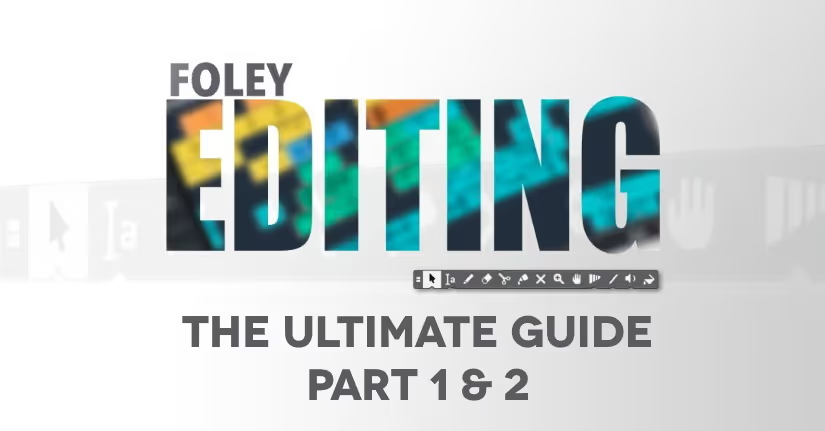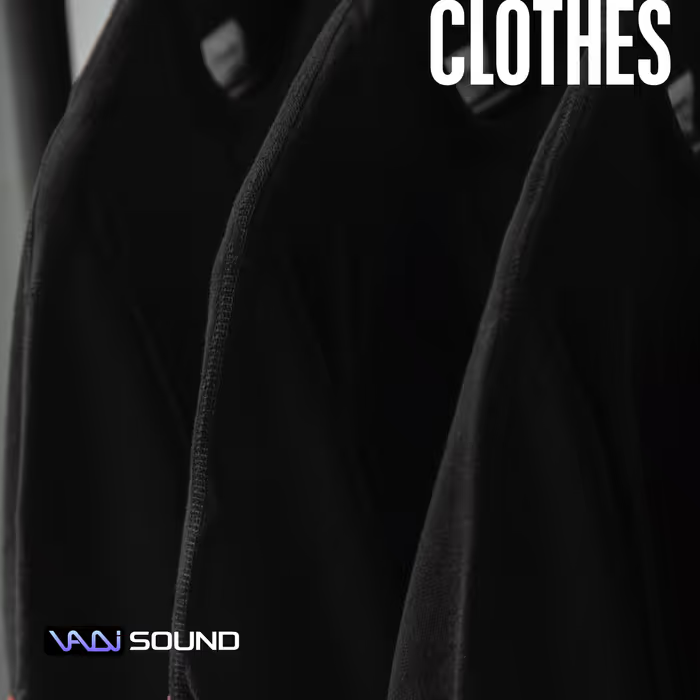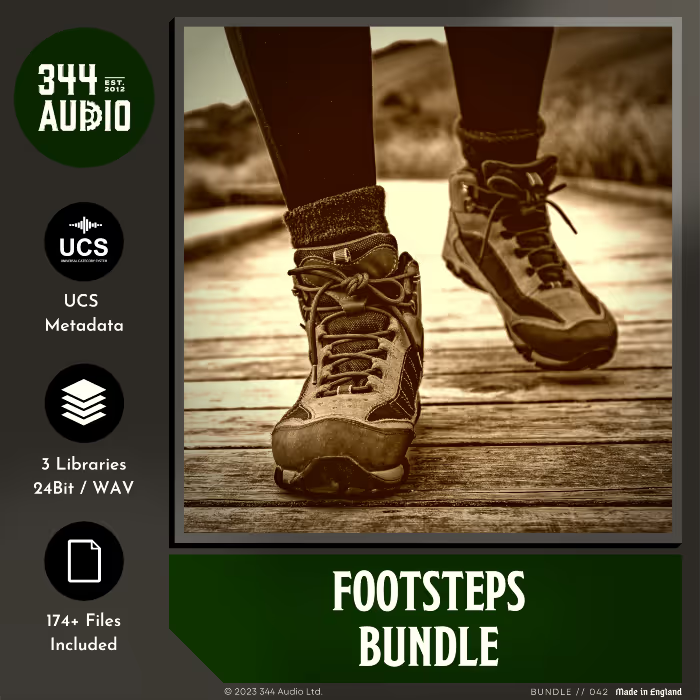Hey! Yuri from Foley First here.
I am excited to discuss Foley editing in the film industry and share our experience in this craft. Since this article turned out to be quite long, it is divided into two parts. In the first part, I will cover what Foley editing is, what the goals of Foley editing are, and the main mistakes beginner Foley editors make. The second part of the article will focus on the basic techniques and tips that we follow here at Foley First to get great results in Foley editing.
WHAT IS FOLEY EDITING? GOALS
Foley editing is one of the most important stages in Foley production. The Foley editor, like the Foley artist, is a key player in the re-creation of sound effects, as he or she not only does the technical work primarily of putting sounds in sync, but can also significantly affect the audience perception by creating and modifying the material recorded by the Foley artist.
I often see situations where one person takes two positions, such as Foley recordist/mixer and Foley editor, on the same project. I can’t say that this is a good idea and that it won’t harm the quality of the material produced, since the amount of work required for Foley recording and Foley editing are comparable. It is hard for only one person to take care of everything in a short timeline. But I do understand what studios or companies are guided by when they assign two positions to one person.
I consider an experienced Foley editor to be a significant player on the Foley team, especially if he or she totally understands the Foley artist and knows how to work with his or her material. If this tandem is well-coordinated, the whole process will be stress-free, fast, and creative. The Foley editor may seem to be just a person who puts sounds in sync, but let’s dig a bit deeper.
More than just putting sounds in sync
Yes, the priority of Foley editing is putting all the sounds in sync as precisely as possible. Each sound effect or group of sounds (such as footsteps, props, and clothes) must be perfectly synchronized with the picture and the action that the characters perform on screen. In this article, I will not discuss exactly how we do Foley editing or what shortcuts we use, but I will give you some tips that will help you avoid common mistakes made by beginner Foley editors, which we all also faced in the past.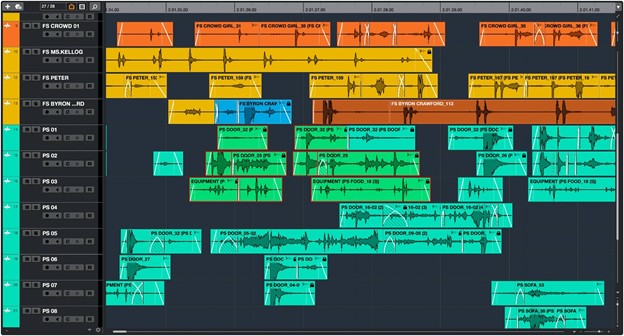
At first glance, Foley editing looks fairly routine and not very creative, but wait. True, a beginner Foley editor must have patience, perseverance, and dedication since at the start of this journey with the highest set quality standards, it will not be easy. You can count on that. But after a Foley editor learns the technique of putting sounds in sync well, he or she begins to do this technical work reflexively and at the same time starts to think wider to understand the film and to feel the creativity in the industry fully. Foley editors start to think like a dramaturgist.
It’s hard to understand the bliss-out of working on Foley before you’ve mastered basic editing techniques, but once you have, you will feel it.
Foley editing is a craft, and only experience will help train the eye to pick up on the difference of sync in 1/2 frame or even 1/4 of the frame while working with material. In the beginning, a Foley editor, as a rule, doesn’t see this difference and doesn’t understand how to edit footsteps to get rhythmical, organic, and even musical arrangements. But if you, as a beginner Foley editor, have a good mentor and a constant flow of projects, then most likely, after 500-800 minutes of edited material, you will be able to see and feel progress and begin to understand how it works not only in the technical but also in the artistic aspects of the work.
Fixing artifacts
During Foley editing, artifacts and unwanted sounds are often found in recordings coming from the Foley stage. This might happen when a Foley mixer/recordist doesn’t have enough time to remove them before delivering material to the Foley editor due to tight deadlines, or if he or she is completely outside his or her competence level in a company.
Things like clicks in steps, props, or cloth recordings should be fixed and removed during Foley editing. Of course, I am not talking about running it through serious plug-ins processing like de-clicker, de-noiser, and others. I mean that the Foley editor can and should fix minor flaws manually before the material gets to the sound effects editor or the re-recording mixer’s desk.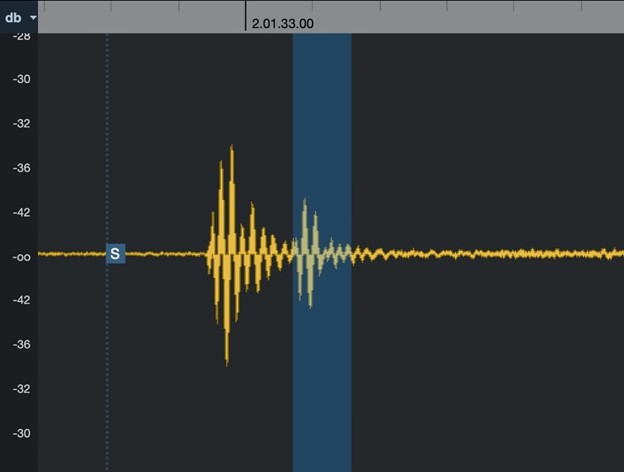
It’s great if a Foley recordist provides notes for the Foley editor about what he or she doesn’t like in the recordings and what he or she can’t fix at the Foley recording stage so that the Foley editor knows what to pay special attention to fix or improve later. To do this, the Foley recordist must know how Foley editing works and be certain that the Foley editor can fix the flaws in the recording. For example, as a Foley artist covering all the footsteps, I might like a specific shoe, its weight, the surface texture, and how it all together glues to the character on screen in the feature film. But maybe I don’t like that the shoe translates some minor artifact that I know can be fixed at the Foley editing stage. So, in this case, I don’t waste time on shoe repairing. Instead, I continue recording, but leave a note in the project session for the Foley editor.
When the whole team is in close cooperation and focused on the result, the result will be great.
Artistry improvement
An experienced Foley editor is a wizard. As I said, having mastered basic technical skills, the Foley editor starts to understand the film and characters. This is important because when the Foley editor feels and understands the character, he or she can subtly work with each recorded footstep individually and with the material as a whole. Working with takes, the Foley editor can not only correct technical flaws in steps or props but, above all, compose interesting and artistically accurate arrangements of steps and characters’ movements. In addition, a Foley editor can modify them, changing the character’s mood.
«What is he talking about?»
Okay. Imagine a Foley artist trying to recreate an artistically and technically complex bunch of character footsteps in a long scene. None of the takes entirely falls into the category of ideal, but the Foley artist knows that he likes the performance of the first half of the footsteps in the first take, the performance of a second third or so in the fourth take, and the performance of the rest in the ninth take. Additionally, the Foley artist provides notes pointing out several footsteps which, perhaps, would be better to replace, resorting to alternate takes for those individual steps. Talk about a crazy and meticulous Foley artist. (This happens!)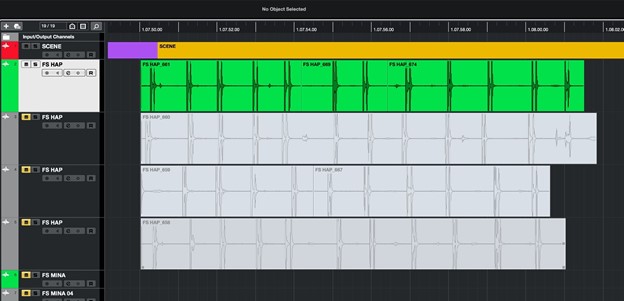
In this case, the Foley recordist/mixer can compile footsteps from different takes, getting the best arrangement (the ideal take) in both his and the Foley artist’s opinion. However, both (Foley artist and Foley recordist) did so many takes that they got tired, blurred their ears, and were not actually sure of the result. Consequently, they let the Foley editor know that it would be worth paying special attention to the arrangement of takes in the scene. For her, as a person with fresh ears, it seems that the other two have gone crazy, and she replaces some of the steps from other takes during the Foley editing in order to improve the footsteps arrangement and more accurately convey the emotion of the character.
I believe that a large team at all stages of Foley production can make significant product improvements. Everyone has to do their job. That is why the idea of combining positions of Foley mixer/recordist, Foley editor, and Foley supervisor into one person on one project seems to me to be a losing proposition for the project’s quality. (But definitely a win for tight budgets.)
HOW MUCH TIME DOES THE FOLEY EDITING TAKE?
Golden rule and editing accuracy
- One day of recording is one day (or more) of editing.
This is a rule that is universally applicable for estimating Foley editing effort. If less time is spent, then most likely it will not be precisely edited material.
Yes, you can assume that the amount of time required for Foley editing primarily depends on the quality of the recorded material and Foley artist’s skills, but believe me, you will spend approximately the same amount of time nudging the clip 2 frames up or 5 frames up if you know in which direction to nudge.
The most important factor affecting the time spent on editing, in my opinion, is the editing accuracy and how accurate a sync your eye can see. If the 1-frame snap grid is the main tool for the Foley editor, it will most likely do its job quickly. But I’m pretty sure that the resulting work will have a rough sync. Maybe some of the re-recording mixers won’t see this rough sync, but most of them will, especially on big screens. It’s another thing when the Foley editor works with a grid of +-1/4 or +-1/2 frames and can see the difference of half a frame. In this case, the time spent on Foley editing cannot be less than the time spent on recording. Often it’s even more.
In addition to editing accuracy, several other factors also greatly influence the time spent on Foley editing. I’ll discuss them in part two of this article, which has more on Foley editing techniques.
No Foley artist can perform ideally
I am convinced that no Foley artist can record material that does not require Foley editing. I also believe that if you dig deeper, almost every sound has imperfect sync, inexact length of “phases,” and requires basic fade-in and fade-out fades.
Generally, for a beginner Foley editor, it seems that the material that comes from the Foley stage is already good enough, and everything sounds and looks in sync. An experienced Foley editor, though, will always see a lot of work that needs to be done. Yes, the standards are different for everyone, but be sure that, as a rule, the Foley editor is not left out of any project, no matter how experienced the Foley artist is.
FOLEY EDITING DURING RECORDING. IS IT A GOOD IDEA?
I think it’s a good idea if the Foley mixer/recordist has some time to put the recorded sound in sync. That will help the Foley editor to easily navigate the recorded material in sound-rich scenes. Nevertheless, it will not (and cannot be expected to) look like completely edited and finished material because it is impossible, without loss of quality, to do in an hour what properly requires 8 hours.
I also think it’s great when the Foley recordist has several films under his belt, edited by him personally—or at least has some quick editing skills. This experience is beneficial in Foley recording. For example, a Foley artist might perform a complex arrangement of steps, but can’t do it as synchronously as he wants because it requires him to simultaneously see if he misses steps and whether he is performing correctly or not. In this case, the Foley mixer can do quick rough edit to make sure that the recorded material is decent for fine-editing, and then the Foley editor will finish the job for sure.
PREPARING FOLEY SESSION FOR EDITING
Check your frame rate
I prefer to use my own project template for Foley editing and import tracks from the session that came from the Foley stage instead of editing in someone else’s project. Since my template has its own fps, and the imported session can differ, it is crucial to verify that the fps of my session matches the fps of the imported session.
I know that it seems like I’m talking about pretty obvious things, and checking fps really is obvious, or should be. But I also know that around my way, every (absolutely every single one—I’m not kidding) entry-level Foley editor went through the experience of, after completing the work on Foley editing, discovering that they had worked in a session set in a 23.97 frame rate while the imported video file had 25fps. This situation threatens that the entire editing will be damaged after converting the session, and you will have to check or redo your work, perhaps even start-to-finish. So, check the fps.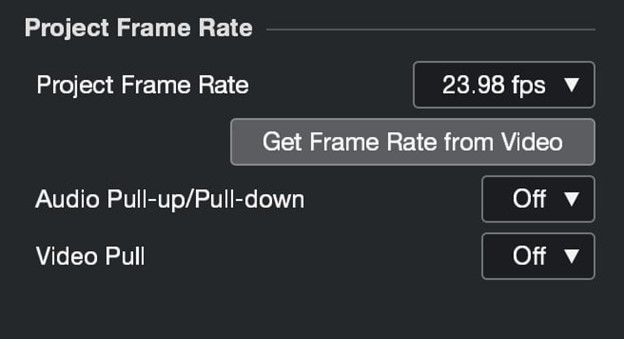
Import guide tracks
Using guide tracks for Foley editing is highly desirable. I would say even necessary. I will tell you why guide tracks are needed for editing in the second part of the article. If your client can also provide you with OMF or AAF files with production tracks, don’t hesitate to ask them to do so.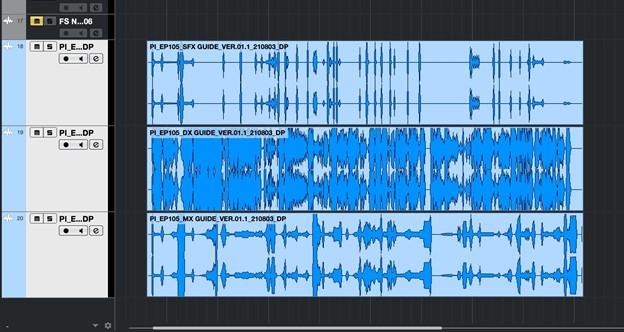
Import Foley session from Foley stage
As I said, I prefer to use my own project template for Foley editing and import tracks from the session coming from the Foley stage. That makes it possible to avoid renaming tracks on each project and keep track colors that are convenient and familiar to me. Generally, my Foley editing project always looks the way I am most comfortable with and understand at a glance, with engrained tracks layouts, folders, rulers, and sometimes even plug-ins.
TECHNIQUES THAT LEAD TO MISTAKES
All Foley editors in our team went through the learning path from scratch. Thanks to the help of the senior Foley editor and Foley supervisor and a constant stream of projects, they became professionals in this craft in six months to a year. Starting at the beginning of their journey, though, all the team members (and I) made the same systematic mistakes, which sometimes led to the wrong technique for accurate and efficient editing. In addition to the fact that this was happening on our team, we sometimes hired freelance Foley editors for contract work on projects. Surprisingly, we discovered that their editing techniques sometimes led to not carefully synced material.
Here are some techniques that I have found can lead to mistakes in Foley editing.
Spotting by frame
Spotting by Frame is probably the number one most common mistake beginner Foley editors make. I frequently see a beginning Foley editor trying to spot the single frame on the screen where the action starts in order to put a clip with the Foley sound right there, in that single spot. This is especially true for Foley footsteps when the Foley editor, step by step, tries to spot the frame on screen with the point of contact of the foot with the surface and put the sound there. After that, a Foley editor thinks that the work is done.
What is the problem here?
The problem is that people are watching the movie on the playback.
Therefore, the Foley editor should also work with the material, finding perfect sync using his eyes, on playback.
The method of syncing sound to the spotted frame can be used to roughly determine the sync when the Foley artist performed much earlier or much later action in the shot. But later, more accurate editing is required using at least 1-2 seconds pre-roll playback. This is especially crucial for editing Foley footsteps because if the Foley editor puts the beginning of each step under the frame where it saw the contact of the heel with the surface, this does not mean that on playback the steps will look synchronous.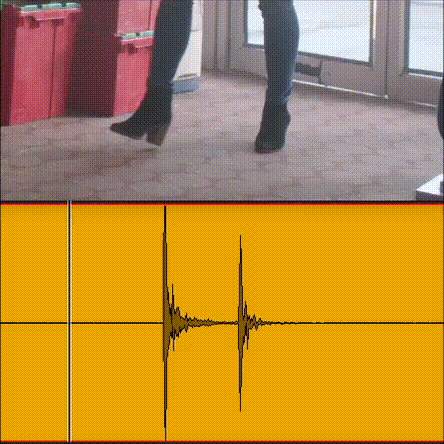
Short pre-roll playback
The top number two mistake is when the Foley editor does not use significant pre-roll playback to check the sound sync. For example, the Foley editor tries to place the step in sync using a short pre-roll on playback of less than one second. I will discuss the pitfalls of this method in the second part of the article.
Failing to check it twice
Even if the Foley editor does not have time to double-check his work, he needs to find this time. I am firmly convinced that self-checking in Foley editing is one of the key factors affecting the quality of the delivered material. After the Foley editor has finished editing the scene, it is crucial to double-check the entire scene on playback. As a rule, during a double-check you will find that 10-30% of the material may require corrections or improvements.
Foley Editing Guide – Part 2:
The key to creating perfectly edited material: Knowing shortcuts and macros – You need to become a shortcut ninja!
Yes, you definitely have to learn all the shortcuts and, even more, know how to create macros if the DAW or other third-party software you are working on allows you to do it. The process of Foley editing consists of thousands of repetitive routine actions, and saving even a fraction of a second for each of them can significantly reduce the overall work time spent on film editing—and make the process more enjoyable. For example, if you were to use the mouse and the top corners of the clip to create the fade-in instead of using a shortcut like “apply fade-in to cursor,” you can imagine how much time you would waste in processing, say, a thousand clips.
We work in Nuendo, and assignable shortcuts and programmable macros are an everyday thing here. Macros are an excellent tool for scripting an action queue that can be applied with just one click.
As an example: personally, before starting Foley editing, I prefer to prepare all the clips. This process involves cutting the unnecessary information in the clip before and after the audible Foley sound itself and then applying fade-in and fade-out to the cropped area. I can’t calculate how many actions I have to take to get a clip in a prepared form, even using all the known shortcuts. But by creating a script and programming macros, this preparation process can be performed in 2 clicks for each clip. That’s a huge time saver!
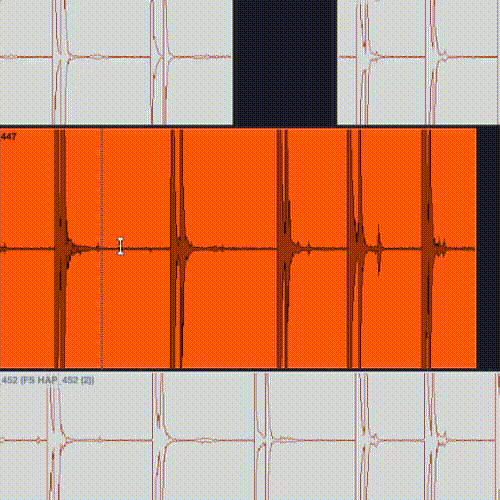
+-1/2 frame grid
As I discussed in the Golden rule and editing accuracy section, it is very important which snap grid you use for Foley editing. A beginner Foley editor can usually see the difference of sync by 1-2 frames, but, gaining experience, the eyes and the brain begin to perceive differences up to 1/4 of a frame, especially in dynamic scenes. I recommend using snap grid + -1/2 frames. Nudging clips with a step of 1/2 frame is also optimal for footsteps and props fine editing, in my opinion.
Using pre-roll
The way a person perceives sync with ears, eyes, and brain when using a long pre-roll is very different from how we see sync when playing the sound using a fraction of a second as a pre-roll. Therefore, I would recommend using a couple of seconds of pre-roll to the targeted sound as a general rule.
It’s not just your eyes and ears that require a long pre-roll. Another factor that can cause inaccuracies in Foley editing when using a short pre-roll is that your DAW and codec may take a moment to stabilize, especially when using external decoders.
That’s also why it is important to do double-checking and, in particular, to check the editing of the entire scene as a whole, from start to end on playback. At this stage, you check the sync not of each sound individually but watch the whole movie in a group with all the other Foley sounds.
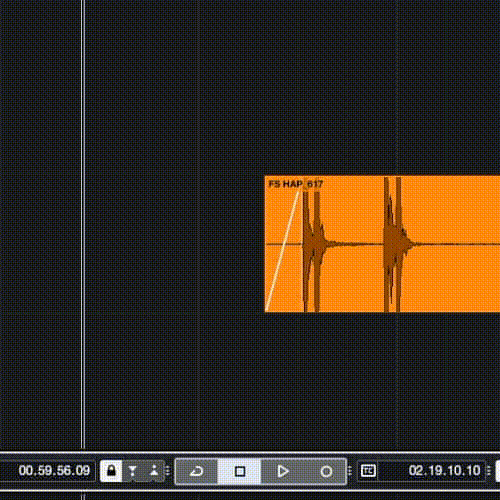
The use of long pre-rolls in footsteps editing is especially crucial. As a rule, I do not put each step into a frame in the picture where we see the contact of the foot with the surface, but instead I create a footsteps bundle by progressively building an arrangement starting from the first step. Step by step. This definitely increases the time spent working on the material, but it improves the quality of Foley editing.
To help you understand what I mean, imagine that we have a character’s walk pass consisting of twelve steps. I mentally arrange the steps into three “bundles” of four steps each. Starting with the first step, I put it in sync by eye using pre-roll playback. Then I move on to the second, but I work on it in context, always letting the first step sound as part of the pre-roll. Next is the third step, and then the fourth. By this time, for the fourth step, my pre-roll is as long as it takes for me to hear all four steps in the chain. After completing the first four steps, I move on to the next bundle of the next four steps using the same method. Finally, I work on the last four steps.
This method allows me not only to do technically synchronous editing, but also helps me to compose organic and musical phrases. Working on a bundle of sounds is very different from working on each sound separately. After I’ve finished Foley editing all the steps, I go back to the first step and play the entire phrase of twelve steps from start to end. Believe me, even after such involved self-checking within the arranged footsteps pass, you will still find minor flaws that require subtle adjustments, both in terms of syncing and, possibly, in terms of the Foley artist’s performance.
As I said in the first part of this article, Foley editing is a technical and, most of all, very creative work, somewhat similar to a musical one.
If, in working on a steps arrangement, it seems to you that one of the steps looks out of sync no matter what you do, try to nudge the step in front of it instead. Perhaps it’s actually this step making your eye and brain think that the next step is out of sync.
Working with guide tracks
Foley is an addition to the production soundtrack and sometimes its complete replacement. You don’t know how the re-recording mixer or sound effects editor will use the material you deliver—whether they will use it in addition to the production track to enhance the scenes, whether the scene will be completely recreated with ADR so that all recorded Foley will be required, or whether they will refuse to use Foley in the scene altogether. Despite not knowing how your work will be used, it’s best to have all of your edited material in sync with the production soundtrack as much as possible. This applies to both footsteps and props.
If in the guide tracks we can hear the steps of a character, then the recorded Foley footsteps of the same character should be fully synchronized with the guide track and sound in unison.
It’s worth noting that there are times when some scenes or fragments of scenes in the guide track are initially out of sync with the picture. In this case, we do not use the guide track as a guide, but sync the Foley by eye.
The guide track in the video file often contains a mix of all the production soundtracks and can also include a music soundtrack, which is not always desirable during recording or editing because it can make it difficult to hear the steps in the guide track. If you have the chance to request a session with multichannel production soundtracks or separate DX / MX / SFX stems from an editor, do so. It is likely that in one of the booms or stem you will hear something that you will not hear in the guide track contained in the video file.
Fades
In the sessions of other Foley editors, I have seen fade-in and fade-out having not only linear but also exponential and even custom complex curve shapes. We almost always use the linear fade-in and fade-out for all groups of sounds, and, personally, I see no reason to waste time building non-standard curves.
Working with Foley “microscopically,” it is effortless to dig yourself in excessive perfectionism and technical nuances that don’t make sense during re-recording.
Yes, perhaps when you’re listening in a solo mode, the clip with the exponential fade-out might sound more accurate than a linear fade-out, but are you sure you will feel the difference in the mix under backgrounds, music, and dialogue?
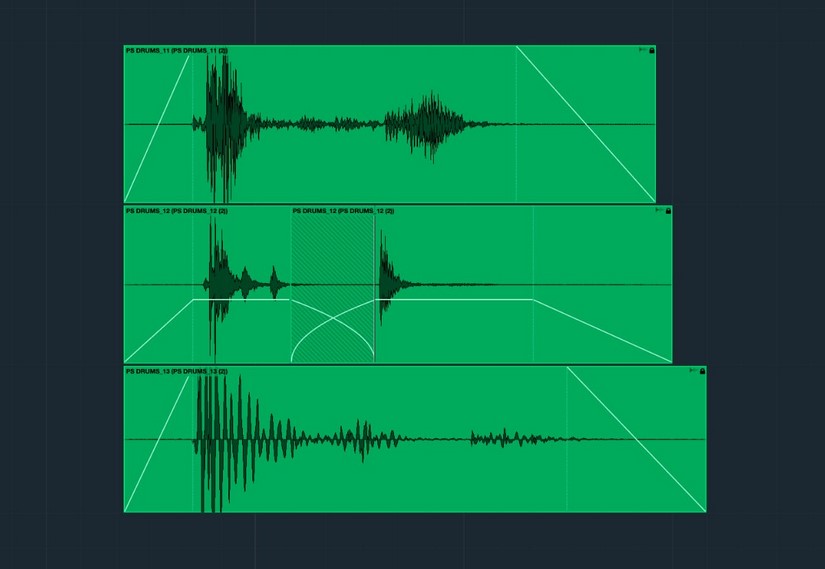
Sliding the contents feature
Nuendo has an awesome tool allowing you to slide the contents of events. You can move the contents of an event without changing the clip’s position in the project window. The content of the clip moves without being snapped to the grid. I have found this option to be very useful in footsteps Foley editing, especially on fast footsteps passes or running where each cut step in the arrangement is very close to the others, and they all have x-fades. In this case, you do not need to nudge the clip of each step and touch the cross-fades, but you can fine-tune the sync using this function.
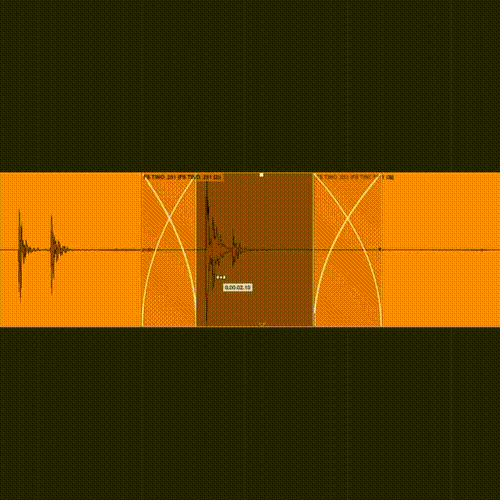
Working with “phases”
Working with phases is key, especially with Foley props editing. By “phases” I mean the sound content within the recorded clip/region which requires precise synchronization with the picture.
For example, the Foley artist recorded the movement of a character’s bag, which involved grabbing the bag off the table, rattling it, opening it, pulling something out, closing it, rattling it again, and putting the bag back on the table in one take. We name each of these separate actions “phases.” Even in short 2 second recorded clips, as in ADR, it is important that all the phases inside are in sync and ideally glued to the picture. It is unlikely that time stretching will be used when working with “phases,” but you can definitely see many cuts and x-fades here.
For beginner Foley editors, it is challenging to work with phases because the inexperienced eye and brain cannot make out inaccuracies in either the performance or the sync of the recorded sounds, just as it’s hard for them to figure out which recorded phase or microphase refers to which action in the frame if we are talking about fast actions in the scene. Only experience and constant training will help you begin to see each phase separately, to understand where it should be moved and whether it should be shortened or lengthened in order to achieve perfect syncing, and, just as importantly, to analyze on the fly if the sound is naturally following this or that phase of the picture or if it requires replacement.
If, when working with short, single sounds like “hands on the table,” “door knocking,” or others, I don’t seem to have a good performance from the Foley artist, I can copy-paste from another place in the film where a similar sound exists. But it’s much harder to find similar-sounding long sounds or phases because most of them are both complicated and unique. If it seems to the Foley editor that the phases of the recorded sound or the entire sound cannot be synced with the picture as precisely as is necessary due to carelessly recorded material, then it’s time to use takes.
Working with takes
Takes play a huge role in Foley editing—I would even say the most important role. Their presence allows us not only to have alternatives to flawed material with a picture, but also provides an opportunity for artistic experiments.
As a Foley artist covering all the footsteps, I always make at least 2 good sounding takes for the Foley editor for later use if the need occurs. However, in especially complex combinations of steps or where I am not sure that my performance and sync are good enough for further editing, the number of takes can be more than 5.
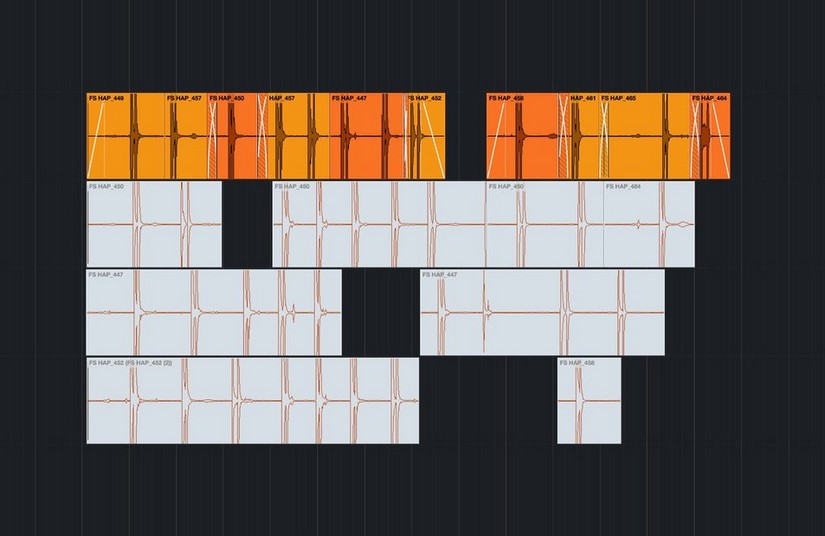
Here at Foley First, we can’t live without using takes. Yes, you might imagine that when the Foley editor does not have alternative takes, the work will go faster and be more fun since he or she will have to work with what is there or find the material as a replacement from other scenes in the film. This may be good for timing, but it generally doesn’t improve quality. And we are talking not only about footsteps editing but also about working with props and replacing the phases of the props. Many technical things can be fixed in Foley editing using takes, and with takes available, most likely the Foley team will not be recording the Foley supervisor’s notes after editing, unless it is about improperly chosen props, shoes, surfaces, etc.
I believe that working with takes is just as much a must-have as knowing shortcuts.
Editing bags and clothes under edited FS
The editing and syncing technique of props (such as bags and clothes) under the edited steps seems correct and effective to me. In this case, the Foley editor does not synchronize steps and props or clothes by eye but does it primarily by ear, relying on listening to the edited footsteps. This method allows you to create musically correct arrangements when both the bass (clothes) and kick (footsteps) sound quantized. I think the musicians know what I’m talking about.
You can read about how we do clothes recording and editing in this article.
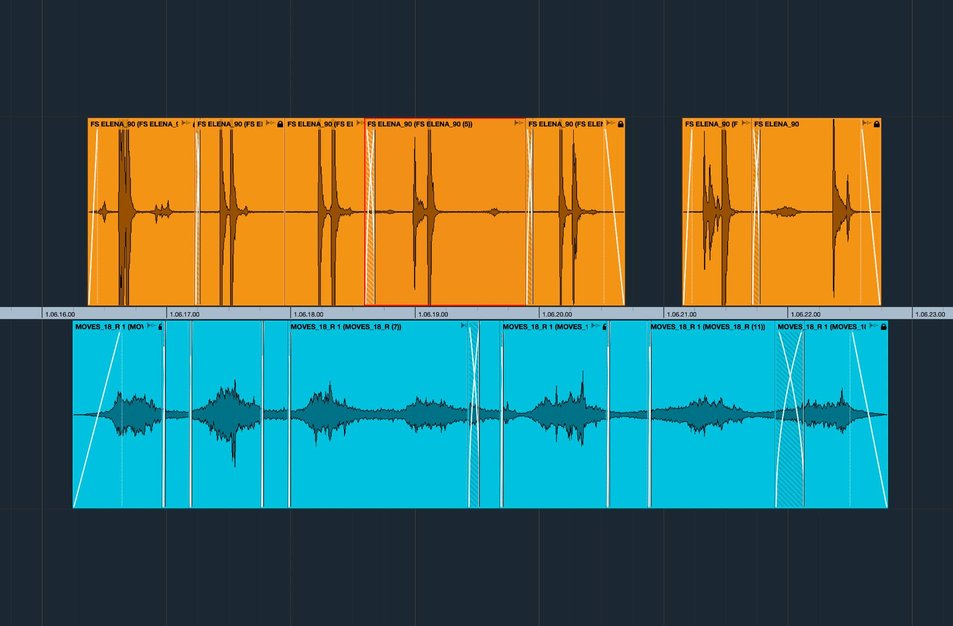
Processing Foley
We have a long article on processing Foley. You can find it here. I want to mention processing Foley in this article as well, as I believe that the processing of Foley, not only during Foley recording but also at the editing and/or reviewing stage, should take place if it improves the recorded material. It can also reduce the amount of time it takes to integrate Foley into the mix for a re-recording mixer.
Checking
It’s important to discipline yourself to always review your work, especially for beginner Foley editors. Working locally with each sound individually, the eye and ear are blurred fast. You have to periodically take short breaks, drink coffee, give the brain a rest, and then look at the scene or individual arrangements with a fresh eye.
Believe me, after a break, there is a high probability that you will find some of the sounds are out of sync, the footsteps arrangements sound bad or inorganic, and inaccurate edits have been made. I believe that if the Foley editor has not checked his work several times, then this work is not sufficiently polished to perfection. Self-checking is a great opportunity to find and correct your own mistakes.
Personally, I prefer to do multi-step checking, starting with checking the edited footsteps. For example, after I have spent some time editing the character’s footsteps for a long scene, I give myself a couple of minutes to rest, and then I check the scene from beginning to end in one pass.
Moving forward, I work with props following the same pattern. After each sound has been synced, it is important to play the entire group of props in the scene from beginning to end without stopping. At this stage, you may find out-of-sync sounds or hear sounds that seem unnecessary in the scene or that interfere with the dialogue. Or it may even turn out that the recorded Foley overwhelms the listener with too much information, and it is better if some sounds are muted.
After taking another short break, I will listen to the entire scene with the footsteps, props, and audible guide tracks. This is a great opportunity to see how the Foley works from a different perspective, not under a microscope, and understand how organically Foley fits in the production soundtrack. It’s great if the Foley editor can do a little volume balance and use reverb for better understanding while reviewing the scene. At Foley First, I prefer to have the Foley supervisor take over this job. As a person with a fresh eye and ear, he or she can find things requiring adjustments that will affect the film’s artistic component but were missed on recording and editing.
Self-checking is one of the most vital things in Foley production. Multi-step checking is even better. Nothing is more motivating than having a client approve your work without notes—when he is happy instead of asking you to fix stupid and obvious mistakes that you missed but could have found just by double-checking your work.
Should I bounce clips?
At Foley First, we prefer to deliver a Foley session that has is non-destructive look.
What does this mean?
This means that any character’s footsteps pass consisting of 10 steps will look like 10 individual clips with x-fades instead of one bounced/rendered clip. This way, the mixer can always modify any fade-in /out or x-fade, nudging or fast deleting each clip/step, etc. In addition, and more importantly, a mixer can use the clip gain option for each separate step instead of having to cut a bounced clip before doing it.
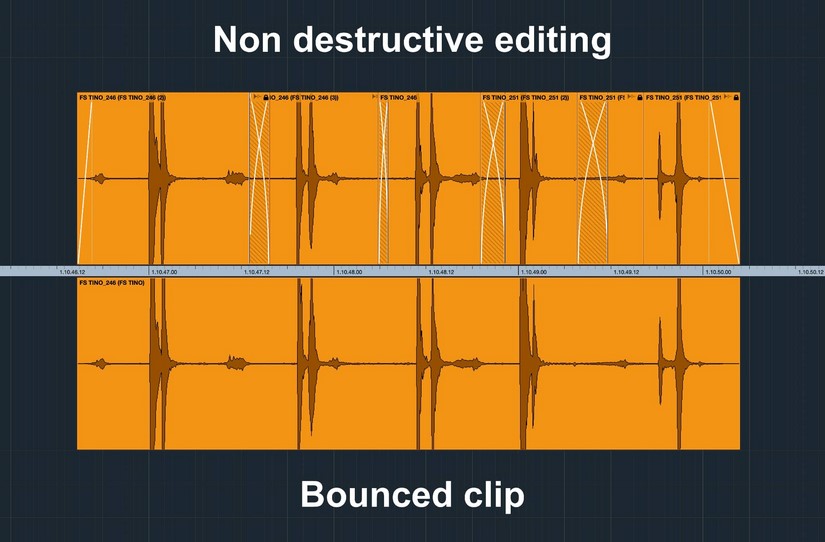
Some of you may disagree with me, and it may seem like the mixer should not see the flip side of editing. So I just asked the mixers about it, and this is what they think:
• “I would say 100% it should be non destructive. Any editing or crossfades should be visible and be able to be changed by the mixer. It doesn’t really matter how it looks on the timeline, just that it sounds right.”
• “I prefer having the individual edits and clips available personally. Individual clip gain ability is what I am mostly like.”
• “It doesn’t really matter much to me if I can see the edits or not.”
These are the tips and tricks we rely on at Foley First to create great edited work! I hope it helps you in your work as well.
About Yuri Pridachin:
Yuri Pridachin is Founder and Sound Supervisor at Foley First, where he’s worked on Foley for 180+ feature and short films, animation and documentaries. Learn more about their work here

